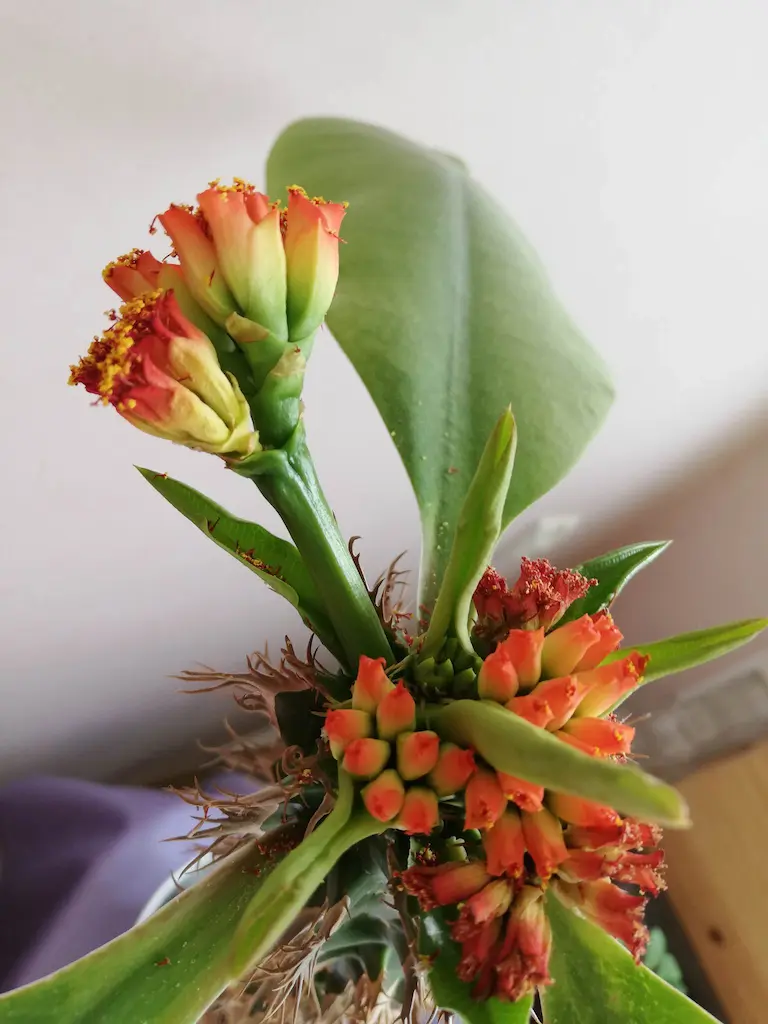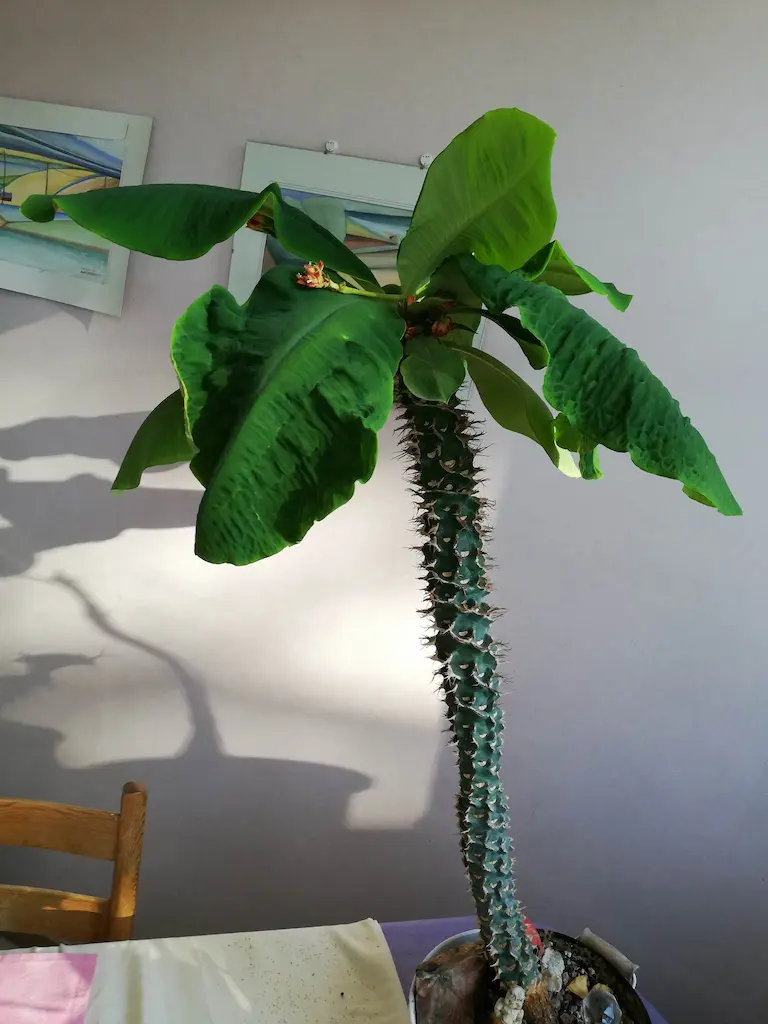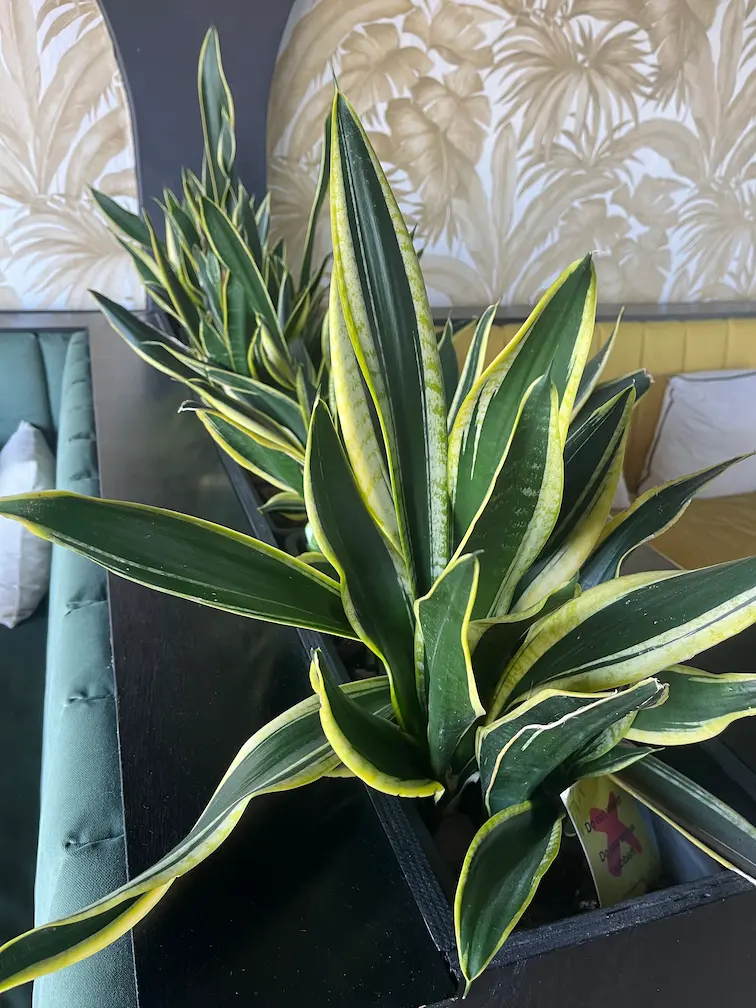
Euphorbia Viguieri flower above
Top Shade Loving Succulents
When we think about growing cacti and succulents inside houses and apartments, there are often concerns about insufficient light, especially during the darker months. After all, a balcony or windowsill has limited light compared to their arid natural habitats where they have full sun exposure all year long. We will list a top list of favorite shade loving succulent plants, most of whom prefer protection from full sun.
Remember that throughout this article, when we informally use the term “shade succulents,” we are always referring to indoor or outdoor environments that receive good indirect lighting. Landscapers use the term “partial shade” as a definition, in which the sun shines directly on the plants only at the beginning of the morning or the end of the afternoon. Although partial shade is the ideal situation for many of the succulents mentioned here, I usually grow them all in a shaded environment in an apartment, where sunlight does not directly shine on the plants at any time of the day. The advantage of shade succulents is that they do not show clear signs of weird growth from insufficient light, such as elongated growth. Succulents that like shade are a good option at home since most plants will compete for the prime spot for full sunshine.
Euphorbia Viguieri
There are plenty of Euphorbia species that prefer a life in the shade and happily sit at a northern-facing windowsill. One challenge with many Euphorbia is that their seeds are only viable for a limited time and therefore they are more difficult to come by, unless you want to buy it on eBay and pay expensive shipping. Euphorbia Viguieri is a very spectacular species that grows erect with sharp spines covering the branch once the leaves have fallen. During random times of the year, the plant will produce small but eye-catching flowers on the very top of the new growth. If pollinated, the seed capsules will dry and eventually explode of tension and shoot the seeds far away to hopefully germinate one day. Be aware that the sap from many Euphorbia plants can be very toxic and should always be handled with care.
Gasteria
Gasteria species are another genus of succulent plants that is often overlooked, despite being quite ornamental. Its closest and most famous relatives are those belonging to the Aloe (Aloe vera and Aloe juvenna) and Haworthia (Haworthia retusa and Haworthia limifolia) genera. Gasteria succulents are excellent options for those who live in apartments, as they are small plants that do not take up much space, come in a multitude of colors and shapes, and tolerate cultivation in partial shade. The main care in their cultivation is the same for all succulents: well-draining and sandy soil, without excess watering.
Euphorbia Viguieri below

Haworthia
The second place in this selection is occupied by an entire genus. Actually, two genera, depending on who classifies them, since some Haworthia species are now considered Haworthiopsis. These are typical shade succulents. Although they inhabit arid and rocky regions, these plants are often partially buried in sandy soil or protected by rocks. For this reason, they are not accustomed to full sun and should be planted in shaded environments. One of the most common species is Haworthiopsis attenuata, also known as the Zebra plant, due to its striped leaves.
Sansevieria trifasciata 'Laurentii
Sansevieria, also known as the “snake plant,” is a diverse and beautiful succulent genus that thrives in shaded areas. Although the name may seem complicated, it refers to the ubiquitous succulent commonly known as “Saint George’s sword.” The original species is Sansevieria trifasciata, but nowadays there are various hybrids available in different colors and sizes. The Sansevieria Moonshine, a beautiful variety that has broad, smooth, and light-colored leaves with a fascinating grayish tint, has already been discussed on this blog.
For apartment gardeners, it is worth noting the Sansevieria trifasciata ‘Hahnii,’ an exciting miniature variety of Saint George’s sword that forms delicate rosettes of succulent leaves with different colorations and patterns. Another stunning variety is the Sansevieria cylindrica, commonly known as Saint George’s lance, a succulent that usually comes braided from the producer. Many gardeners untangle the arrangement as soon as they arrive home, although it is a bit stressful for them.
In all its shapes and sizes, the Sansevieria genus is versatile, adapting well to shaded growing areas such as the interiors of homes and apartments. Still, it can also be easily maintained in outdoor areas under full sun. It is a virtually indestructible plant that requires very little maintenance. Its greatest enemy is over-watering. It is worth remembering that both the Saint George’s sword and lance are toxic if accidentally ingested by children or pets.
Sansevieria below

Dorstenia Foetida
Dorstenia are a family of unique looking natural bonsai succulents with a very thick caudex, visible directly from germination. They are native to Madagascar, which is home to a myriad of indigenous species of plants and animals. They prefer to live in a small pot and dry out between waterings and are rather easy to care for. Their flowers are truly unique, and resemble a drawing of the sun, where lots of seeds will appear after pollination. Once the seedpod is dry it will create a lot of tension, where the seeds eventually will shoot across the room and spread the seeds. Dorstenia plants are very interesting additions to any plant collections.
Senecio Rowleyanus
Continuing with our selection of shade succulents, and still in the same line of trailing plants, we have the famous String of Pearls. Personally, I love this succulent. I only placed it in the ninth position because it is not typically a shade plant. It tolerates this growing environment, although its development and appearance are much superior in locations with higher levels of luminosity, including full sun. Also known as Rosary, the String of Pearls succulent forms delicate cascades of green balls, which are actually its modified and succulent leaves. Its spherical shape aims to reduce the surface of evaporation, increasing the retention of water, which is scarce in its original habitat.
Rhipsalis Baccifera
The Rhipsalis is another family of succulents that like shade. Despite their unusual appearance and lack of spines, members of the Rhipsalis genus of succulent plants are indeed cacti. Perhaps the most famous member of this interesting group of cacti is the mistletoe cactus, Rhipsalis Baccifera. It is a plant with an epiphytic habit, like orchids. Therefore, the mistletoe cactus does not tolerate full sun, making it suitable for our selection of shade succulents. There are several species of Rhipsalis, which may have an erect or pendant vegetative part. A beautiful example of an erect Rhipsalis is the coral cactus, Rhipsalis cereuscula. These plants are ideal for those who cultivate succulents inside homes and apartments, in more shaded conditions. Due to their epiphytic nature, these plants are used to living in the shade provided by tree canopies. The important thing is to have good indirect lighting in the growing environment for these shade succulent species.
Othonna Capensis
Also known as Ruby Necklace, this plant is not typically an example of a shade succulent. However, it is a species that adapts well to indoor growing locations, as long as they are near a well-lit window. Othonna Capensis does not require full sun to grow and bloom. For this reason, it occupies the eighth place on our list of shade succulents. When well-cultivated and developed, the Ruby Necklace succulent acquires an ornamental aspect of a trailing plant. Its green leaves, along the reddish stems, resemble small cucumbers. For this reason, this plant is called Little Pickles. When it receives adequate levels of light, Othonna capensis produces delicate blooms that resemble tiny yellow daisies.
Sedum Morganianum
This is another example of a succulent that appreciates good levels of luminosity, including full sun, but can be grown indoors, as long as it is near a well-lit window. Although its appearance is not as compact and uniform, this succulent, popularly known as Burro’s Tail or Donkey’s Tail, has long and dense trailing stems, full of succulent leaves in the shape of pointed fingers. There is another variety of this succulent, with the same appearance, but with more rounded leaf tips. Although most succulent plants become elongated when grown in shaded environments, Sedum Morganianum, because it is trailing, does not compromise its appearance too much. It does not acquire that classic necked appearance and can elegantly decorate a well-lit apartment room. This is another example of a succulent that is not typically a shade plant, but can adapt to this type of environment.
Zamioculcas Zamiifolia
Continuing our list of shade-loving succulents, prioritizing beauty, resistance, and ease of cultivation, I introduce the popular zz plant, also known as Zamioculcas Zamiifolia. This plant is perfect for shaded environments and dislikes direct sunlight. Its shiny, waxy leaves can become scorched if exposed to too much light. Like all succulents, it cannot tolerate excessive moisture in its roots.
Unfortunately, this is another example of a toxic plant. However, it is sufficient to keep it in a higher location, out of reach of children and pets. Its tall and erect posture makes this task easier. The zz plant is ideal for those darker corners of the house where the light is insufficient for most other ornamental plants. It is worth remembering that no plant can survive in the dark, in the absence of light.

Portulacaria afra
Portulacaria Afra is a succulent species that is often overlooked by beginner gardeners but has interesting characteristics. Its size is similar to that of a jade plant, but its leaves are smaller and more delicate. It also has the appearance of a small tree, resembling a bonsai. As the succulent grows older, the stem becomes more lignified, giving the appearance of a tree trunk. They don’t necessarily need shade to be happy, it is just as happy in full sunshine.
Compared to Crassula ovata, Portulacaria Afra grows more rapidly. However, its size tends to be smaller and more compact. This is another intriguing option for a collection of succulents.
